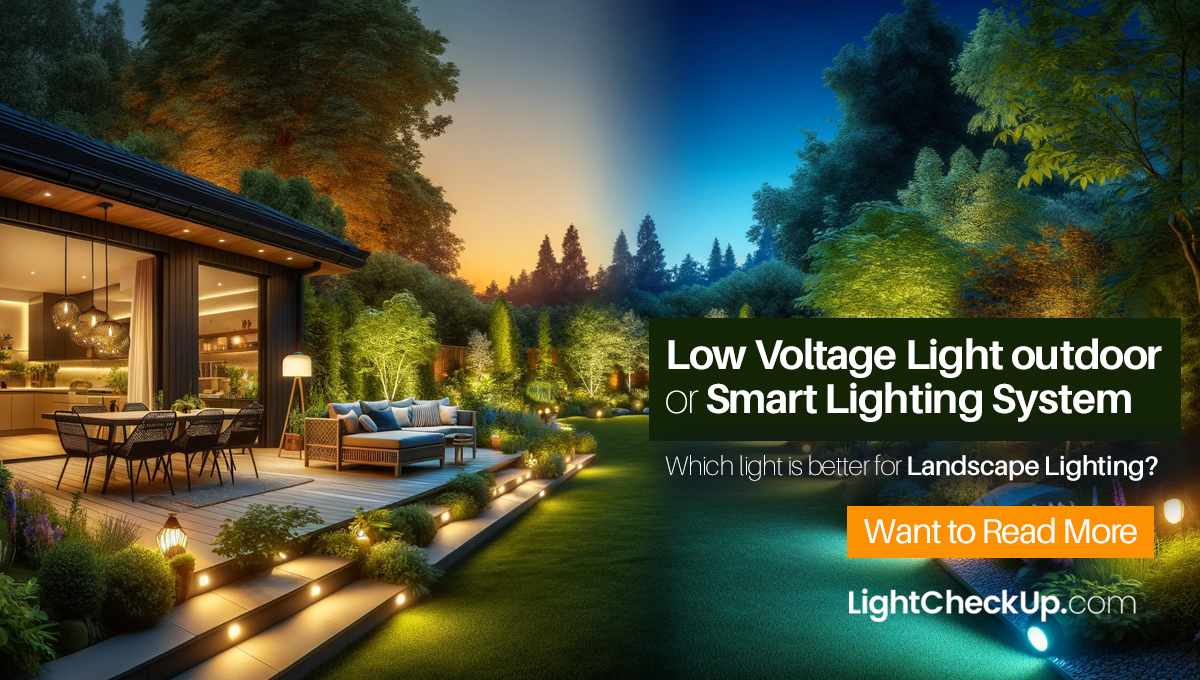Low voltage lighting and smart lighting systems are popular choices for creating outdoor ambiance. But which is better for your landscape lighting needs?
You can truly transform your outdoor space with the right lighting. However, when it comes to landscape lighting, two options often take center stage: low voltage lighting and smart lighting systems. Your specific needs and preferences will determine the best choice for you.
In this blog, we will discuss why we use Low voltage outdoor lights. Is it difficult to install low voltage landscape lighting? How to do that?
We’ll also explore smart lighting systems and help you decide which option is best for your outdoor oasis.
Why low voltage lighting?
A low voltage light source is becoming increasingly popular for landscape illumination, and it’s easy to see why! These are some of the key benefits they offer:
Low voltage outdoor lights is much safer than standard line voltage lighting, which can be dangerous if installed incorrectly. It’s especially important in humid outdoor environments.

Energy Efficiency: Low voltage outdoor lights save energy. In addition to reducing electricity bills, they also reduce environmental impact.
Versatility and Design Freedom: Low voltage systems are more flexible in terms of design. It is easier to install smaller transformers and thinner wires in tight spaces and around plants, enabling creative lighting arrangements.
Safety in Wet Locations: Low voltage outdoor lights are generally considered safe for use in wet areas, such as around pools, ponds, or gardens, since they operate at lower voltage. In this way, they can create a safe and inviting outdoor atmosphere.
Additionally, lights low voltage outdoor systems often include LED bulbs as standard, further enhancing their energy efficiency and lifespan. Landscape lighting with low voltage is a great option due to its many benefits.
Read Also: Outdoor Landscape Lighting Repairs: Save More With Easy DIY Fixes
Do smart lighting systems perform better than low voltage lighting?
Low voltage outdoor lights combines safety, efficiency, and flexibility, but smart lighting systems offer a whole new level of control and customization. Here’s what you need to know:

Smart lighting systems use wireless technology and smartphone apps to remotely control your outdoor lights. The result is features such as:
- Turn lights on and off at specific times to create a welcoming environment.
- You can dim your lights or even change their color to create different moods.
- Google Home or Amazon Echo smart speakers can control your lights with your voice.
- Create automated actions with lighting system integration with other smart home devices, such as motion sensors and security cameras.
How much does it cost to install low voltage outdoor lighting system?
Low voltage lighting systems cost can vary based on several factors, including:
- It is naturally more expensive to set up a large area of lighting with intricate designs than to set up a smaller, simpler landscape.
- Cost varies according to the type of light and the number of fixtures. Path lights cost less than spotlights.
- A lot depends on materials and labor costs, such as transformers and wire, as well as the labor cost for installation.
In general, expect to pay between $100 and $325 per fixture, including installation and materials. DIY options and purchasing materials separately can reduce costs.
Remember, if you have any doubts about the installation, consult a qualified electrician.
Read Also: How Safely Tie Off Interior Home Lights: A DIY Guide For Every Fixture
Can you use smart lights outside?
That’s right! Smart lights with weatherproof casings and dimmability are perfect for outdoor use. A smartphone or voice assistant can control these devices, elevating your landscape design.
Read Also: Exterior Home Spotlights: Safe And Simple DIY Installation Steps
Why are my low voltage lights not working?
Troubleshooting Your Voltage Lights:
Here are some common problem for dim low voltage lights:
- Faulty bulb: Replace the bulb with a compatible low voltage option.
- Loose connections: Make sure all wires, transformers, and lights are securely connected.
- Transformer malfunction: Maybe the transformer is faulty if it’s hot or buzzes.
- Tripped circuit breakers: Reset any tripped breakers dedicated to your landscape lighting in your home’s circuit breaker panel.
The advice of a qualified electrician is recommended for more complex problems.
How many low voltage lights are per transformer?
The number of lights low voltage outdoor that can be connected to a single transformer is determined by its wattage capacity. You should not exceed the transformer’s power rating with your lights. Please refer to the transformer’s manual or manufacturer’s website for information. It will specific wattage limit and how many lights can be safely connected.
Read Also: How Do You Use Outdoor Task Lighting? 5 Amazing Benefits That You Must Know
Are LED lights voltage sensitive?
In general, LED lights do not suffer from voltage sensitivity within a certain range. These devices require a driver circuit to convert incoming power to the proper voltage. LED bulbs need transformers to receive the proper voltage in order to function properly.
Do low voltage lights use less electricity?
Traditional outdoor lighting options use significantly more electricity than low voltage systems. The reason for this is that they operate at a lower voltage, thus requiring less power to illuminate your landscape.
Additionally, LED bulbs are renowned for their energy efficiency and long lifespan, so you’re using less energy.
Read Also: 5 Amazing DIY Closet Design With Illuminate To Light Up Your Closet
In conclusion, both low voltage lighting and smart lighting systems have their advantages and disadvantages.
Low voltage light bulbs is an easy-to-install and cost-effective way to enhance the beauty of your landscape. Smart lighting systems offer advanced features and customization options, allowing you to control your outdoor lighting from anywhere.
You have to choose based on your budget, desired functionality, and personal preferences.
Read Also: Troubleshooting Landscape Lighting: 6 Quick And Simple Fixes








